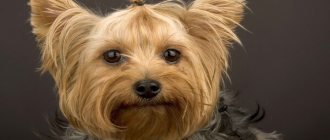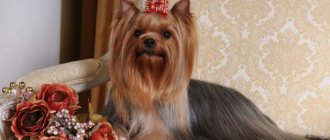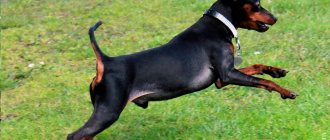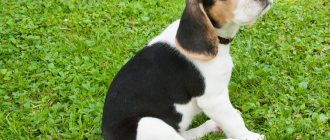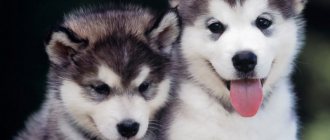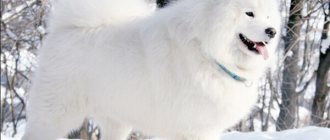Origin
These dogs are a very ancient breed. There are references to Skye Terriers in England in books dating back to the 16th century AD. Scientists who have studied the history of the appearance of the species believe that four-legged pets also landed on the Isle of Skye in Scotland with sailors. Dogs from Spain bred with Scottish spaniels and terriers, which allowed the formation of the Skye terrier species.
Some time later, representatives of the breed were brought to Great Britain. It was in this country that they gained particular popularity, and Queen Victoria played a significant role in this. She really liked these animals, so in 1842 the queen organized a nursery for breeding Skye terriers. Four-legged pets were used to hunt foxes, ferrets, badgers, and other types of burrowing animals.
After the First World War, the population of purebred animals decreased significantly. Dog enthusiasts decided to correct this deplorable situation: they continued to breed these cute and wayward dogs. But England is not the only country that has been able to appreciate the qualities of Skye terriers. The United States of America, Japan, the Russian Federation - event clubs were represented in each state.
But today Skye terriers are considered very rare, for example, in 2010, according to the statistics of registration of new offspring of the US Kennel Club, this species was in 160th place out of 167 possible. Unfortunately, the British Breeders' Club considers Skye Terriers to be endangered in the country. This statement is confirmed by the fact that in 2005 only 30 purebred puppies were registered.
History of the ancient breed
The breed is over 600 years old. The first mentions of this dog date back to the period of the Roman conquest of Foggy Albion.
Did you know? The story of the Skye terrier of Mary Stuart, the Scottish queen, executed by order of the English Queen Elizabeth, is known: the dog, soon after the execution, also died of a broken heart, refusing to eat.
In one of the ancestral Scottish castles, documents were found confirming that already in the 14th century the breed standard was more or less determined:
“Let your Skye measure 9 inches at the standing shoulder, 2.5 times that length in length. The tail when extended is equal to its height and the head half an inch smaller. The lower fur (undercoat) is as soft as sheep's wool. The top coat (guard hair) is similar to a pony's mane.
With chestnut eyes, close-set and attentive; strong in jaws and teeth; having a keen sense of smell and intelligence. He attacks his enemy like a winged arrow. Treat him tenderly, like your best friend. Prefer him more than other favorites, and he will not know anyone except his master, and will not listen to anyone else's orders. He will guard your bed when it is empty and keep a constant watch over your grave.” Don't forget that this text is 7 centuries old.
Some Scottish clans began selection and keeping genealogical books only at the end of the 18th century. These dogs lived with their owners in castles, not in kennels in a common pack. There are many more documents confirming the antiquity of the breed and very clearly describing its character.
Queen Victoria of England had a special relationship with this breed. She got Skye in 1842, and she even went with it to meetings of the State Council. Because of this, the breed instantly became fashionable among English aristocrats. There was even a saying that it was unbecoming for an aristocrat to leave the house without his sky.
Did you know? Queen Victoria had a court artist, Edwin Henry Landseer, who painted her dogs. Thanks to him, you can still see what the queen’s favorites looked like.
Following fashion, numerous nurseries have appeared in Europe, specializing in breeding Skye puppies. In 1842, the first breed standard was drawn up. Many pedigree books of these dogs have been preserved in exemplary order, making it easy to trace the lines of almost any noble individual. At the same time, the first dog shows began to be held, which have become commonplace in the modern world.
Appearance
Representatives of this breed are considered special: they are recognized by their original exterior. This is an impeccable coat all over the body, a charming smile, an easy gait and incredible ears. The appearance of the Skye Terrier is represented by the following parameters:
| Appearance | Characteristics |
| Dimensions | The animal belongs to the dwarf breed. The height of an adult at the withers is only 20-25 centimeters. Weight can vary from 12 to 18 kilograms. |
| Head | Powerful, yet long. The transition from the muzzle to the forehead is slightly pronounced. |
| Muzzle | Strong, oblong. The muzzle is crowned with a black nose. |
| Jaw | Strong, balanced. The bite is absolutely correct, scissor bite. |
| Ears | Can be hanging or standing. |
| Eyes | Medium size, small distance between eyes. The look is expressive, the color is preferably dark brown or dark brown. |
| Body | Squat body. The chest is deep, the back is flat. |
| Paws | Short, but with well-developed muscles. The front legs are slightly larger than the hind legs. The claws are strong and the pads are dense. |
| Tail | Has an elegant suspension. Never rises above the back, does not curl at the top. |
| Wool | Double coat: undercoat and guard hair. The undercoat is soft, short and fluffy, and the outercoat is hard, straight and without curls. The fur on the head covers the animal's eyes. The color can be blue, black, red, light or dark gray, fawn. Small white markings on the chest are acceptable according to the breed standard. |
Such outstanding features are unique to the Skye Terrier. Therefore, representatives of the breed are difficult to confuse with other animals.
SKYTE TERRIER (haircut)
Skye Terrier Grooming. Price: 2,000 rub. -a haircut; 2,500 rub. -complex (haircut, wash, ears, claws, paraanal glands);
Skye Terrier Grooming. Price: 2,000 rub. -a haircut; 2,500 rub. -complex (haircut, wash, ears, claws, paraanal glands);
Skye Terrier Grooming. Price: 2,000 rub. -a haircut; 2,500 rub. -complex (haircut, wash, ears, claws, paraanal glands);
Skye Terrier Grooming. Price: 2,000 rub. -a haircut; 2,500 rub. -complex (haircut, wash, ears, claws, paraanal glands);
Skye Terrier Grooming. Price: 2,000 rub. -a haircut; 2,500 rub. -complex (haircut, wash, ears, claws, paraanal glands);
Skye Terrier (Sky Terrier, Skye Terrier) is a breed of hunting dog.
The Skye Terrier is a very ancient breed, originating from the Isle of Skye in the Hebrides, which is located northwest of the coast of Scotland. This explains the name of the breed. It is believed that they were brought to England from this island. The breed was first mentioned in the 16th century in the book “On English Dogs,” written by the famous scientist Dr. John Caius. According to some information, in the 16th century, long-haired Spanish dogs were brought to the Isle of Skye, which were then crossed with local hunting terriers and small burrowing dogs that were kept in England for hunting. It was once a hunting dog, perfectly adapted for fighting foxes and badgers in their underground burrows. It was used for hunting river otters, wild cats and other animals, but in our time the Skye Terrier is rarely used for hunting, since it is hampered in this matter by its beautiful, long, silky coat, which is required by the modern standard. The breed is known all over the world, but is small in number. Monument to Greyfriars Skye Terrier Bobby, the most loyal Skye Terrier. The touching story of the Greyfriars Skye terrier Bobby from Edinburgh has been preserved. After the owner's death, Bobby every day for 14 years went to the cafe where he was used to being with the owner, received a bun and returned to the owner's grave in the cemetery. There he met his death and was buried. In the capital of Scotland, Edinburgh, there is a fountain with a sculpture of a Skye terrier. The monument was erected in 1872 after the death of Bobby, who earned the reputation as the most loyal dog in the world. A Skye terrier named Boss, a favorite of Queen Victoria of Great Britain (1819-1901), was depicted in a painting by the famous English artist Edwin Henry Landseer. Origin: UK. Date of publication of the previously valid standard: 06.24.87
- General appearance: Long, squat, richly clothed, the oblique length of the body is twice the height at the withers. The movements seem completely effortless. Strong limbs, block and jaws.
- Behavior and Temperament: Elegant, self-respecting. A one-owner dog, distrustful of strangers, never malicious.
- Head: Long and powerful, strength cannot be sacrificed for extreme length.
- Skull: The skull is moderately wide at the back of the head, tapering gradually towards the strong muzzle.
- Transition from forehead to muzzle: Slight.
- Front part:
- Nose: Black.
- Muzzle: Strong.
- Jaws and Teeth: The jaws are strong and level, with a perfect, regular scissor bite, that is, the upper teeth closely overlapping the lower teeth and set square to the jaws.
- Eyes: Brown, preferably dark brown, medium in size, narrow set and expressive.
- Ears: Erect or drooping. When erect, with graceful feathering, small, the outer edges are vertical, and the inner edges are inclined towards each other from the apex to the skull. When pendulous, the larger ones hang straight down, are flat, and fit tightly with the front edges to the head.
- Neck: Long, with a slight scruff.
- Last: Long, squat. The sides appear flattened due to the straight falling coat.
- Back: Flat.
- Loin: Short.
- Chest: Deep; The chest is oval, deep and long.
- Tail: When lowered, the upper half hangs down and the lower half is carried back in a curve. When raised, it continues to slope its back, without rising higher, without twisting upward. With an elegant pendant.
- Forequarters: Legs short and muscular.
- Shoulders: Broad, close to the body.
- Hindquarters: Strong, voluminous, well developed and well angulated. The legs are short, muscular and straight when viewed from behind. No dewclaws.
- Feet: The front feet are larger than the hind feet and point straight forward. The pads are dense, the claws are strong.
- Movement: Legs move straight forward when moving. When approaching, the forelimbs form a continuation of a straight line in front, the paws being the same distance from each other as the elbows. The main driving force is produced by the hind limbs, which move straight forward. The front legs are well carried forward without excessive lifting. In general, the movements can be described as free, energetic and effortless, producing a more or less creeping pattern.
- Wool: Double. The undercoat is short, dense, soft and fluffy. The outer hair is long, coarse, straight, smooth and free of curls. On the head the hair is shorter, softer, covering the forehead and eyes. The fur mixed with the side strands around the ears is like a fringe, allowing the shape of the ears to be seen.
- Color: Black, dark or light gray, red, fawn, all with black mazurina. Every solid color allows a shade of the same color and a lighter undercoat as long as the nose and ears remain black. A small white mark on the chest is acceptable.
- Size: Ideal height 25-26 cm (10 inches), length from tip of nose to end of tail 105 cm (41.5 inches). Bitches are slightly smaller with the same proportions.
- Defects: Any deviation from the above points should be regarded as a defect or defect depending on the severity.
- Note: Males must have two apparently normal testes fully descended into the scrotum.
The Skye Terrier's coat hardly gets tangled. The coat must be brushed at least once a week. It is not necessary to cut or trim your Skye Terrier, however, spending a little time trimming the hair around and between the toes and paw pads will help avoid problems due to moisture, twigs, pebbles, dirt, etc. getting there.
Now let's try to figure out how to cut our Skye Terriers . Having more than 10 years of experience working with this breed, I believe that if your Skye Terrier is not a show dog, that is, does not currently participate in such events, then the haircut options can be absolutely any. Dear Skye Terrier owners, a dog is an addition, a piece of you and your style and taste, it is simply necessary to trim your Skye Terrier. The Skye Terrier is a breed that needs proper grooming. Her coat needs proper care, only under this condition will it look great.
Grooming the body of a Skye Terrier:
- “Cut according to the breed”, the haircut is strictly in accordance with the breed standards and the wishes of the owner.
- “Home haircut”, when all parts of the body are cut in accordance with the wishes of only the dog’s owner.
- “Hygienic haircut”, when everything is cut to “0”, you can only leave the hair on the head and where possible.
Haircut of the Skye Terrier's face:
- “Cut according to the breed”, the haircut is strictly in accordance with the breed standards and the wishes of the owner.
- “Home haircut”, when all parts of the body are cut in accordance with the wishes of only the dog’s owner.
- “Hygienic haircut”, all the hair on the face is cut off if it is matted or has an unsightly coat color. In this case, the ears are cut to “0”.
Skye Terrier tail trim:
- The tail is cut short around the anus. The length of hair left on the tail varies depending on the wishes of the owner and the dog’s conformation.
- Or the tail is cut off entirely (you can cut a pattern on the tail in the form of a braid and a tassel at the end).
Grooming the Skye Terrier's paws:
- “Paw cutting according to breed”, only the pads and fur on the paws are cut to “0”, the rest of the hair on the paw is formed depending on the exterior and wishes of the dog’s owner.
- “Hygienic paw cutting”, on the paws, not only the pads and hair on them are cut to “0”, but also higher up, the so-called “socks”, up to the 5th toe (like a Poodle).
Dear Skye Terrier owners, let's move away from the stereotypes imposed on us. You and only you choose to be you and your Skye Terrier as an “exclusive individual” or a “gray mass” like everyone else!
You just need to decide which master’s work you liked. We will do the rest. You don't even need to call yourself.
- You simply sign up on the website to see the master, and send the application to us.
- Or you can order a call back on the website, and we will call you back at a time convenient for you.
Well, when could we even dream that caring for our beloved DOGS and further maintaining all this DOG beauty would be so simple. We decided to move away from the stereotypes of the past imposed on us. Now you don’t need to sign up for a beauty salon and go to a specialist whose work you sometimes don’t know and aren’t sure whether you’ll like the result. And then you will have to pay quite a small amount for the procedures at the cash register at the administrator. The result in most cases is the same:
- Either you liked the master and you would like to continue to be serviced by him, but we all know that the prices are high in a good salon, where there are good, professional and experienced masters.
- Either you didn’t like the master and you have to look for a new one...
We offer you, without leaving your home:
- Choose a suitable master for yourself by looking at his work.
- Agree on the place and time of the procedure (at your home or in the specialist’s office).
- You will get an attractive price, unlike what they can give you in any beauty salon, for high-quality, professional procedures.
We do not skimp on the quality of services ; we have been able to seriously reduce prices for procedures and services due to the fact that we do not rent expensive premises; all our specialists receive clients in their equipped offices. Or they come to your home. The pet salon in Moscow Salon-Zoo.Ru offers the following services: cutting a Skye terrier, show and home dog grooming, dog washing, terrier ear cleaning, terrier nail trimming, dog nail trimming, dog teeth cleaning, dog gland cleaning. Inexpensive dog grooming in Moscow at home or in a salon is a vital necessity for pet owners; it allows you to keep the dog’s coat clean, especially if it participates in exhibitions and needs a model haircut. Our best professional groomers do their work inexpensively (reasonable price) and with high quality. We work in Reutov, Novokosino, Kosino, Nekrasovka, Saltykovka, Balashikha, Novogireevo, Zhulebino, Lyubertsy, Shchelkovo, Kotelniki, Lytkarino, Perovo, Vykhino, Zheleznodorozhny, Ivanovskoye, Golyanovo, Izmailovo, Tekstilshchiki, Kuzminki, Maryino, Brateevo, Kapotnya.
We really value each of our clients!
Advantages and disadvantages of the breed
- original exterior;
- small dimensions;
- devoted and faithful;
- distrust of strangers;
- does not have an unpleasant dog odor;
- tolerates loneliness well;
- smart.
- self-sufficient;
- need an individual approach in the process of learning and training;
- it is necessary to observe regular physical activity and exercise;
- demanding care;
- can be cocky and impatient with other dogs;
- It is not a very popular breed, so it is difficult to purchase puppies.
Breed Features
As soon as the Skye Terrier appears in public, everyone around him is immediately charged with a positive mood. All this happens thanks to the combination of subtle humor and the manners of a true British gentleman in one four-legged pet. But that’s not all: dogs of this species are distinguished by many internal advantages. The most valuable thing is devotion and loyalty, which are not a bit inferior to the famous Akita Inu Hachiko.
Interesting! Skye terrier Bobby received recognition in the form of a monument in Edinburgh (Scotland). His story still touches to the very depths of the heart: a devoted four-legged pet returned to a person’s favorite coffee for 14 years after the loss of its owner. In this establishment, Bobby was treated to delicious buns, after which he returned to guard the grave of his owner.
In addition to boundless devotion, representatives of the species are characterized by courage, strength, and independence. The animal is cautious towards strangers, but if you win its trust and affection, the Sky Terrier will give the person its loyalty and love. In most cases, four-legged pets choose one member of the household to whom they become most attached.
He is loyal to the children with whom he lives and grows up. To avoid shyness, early socialization is necessary. Skye Terriers are sensitive to reprimands, but they do not put up with it. Representatives of the breed are responsible defenders of the owner and the home. They prefer and crave human attention, friendship and affection.
Character
Over its long history, the breed has not lost its courage and passion. When the terrier is engaged in direct duties - hunting - he is distinguished by fury, ruthlessness, and the absence of any hesitation.
The character of Skye Terriers matches the first Scottish aristocrats. He does not tolerate any familiarity or baby talk. But he doesn’t allow himself any familiarity either. He does not tolerate importunity and pestering at all - the annoying person is shown a grin of strong white teeth.
In between times, he will not even communicate with the owner, hinting that if it is decided to pay attention, then it should be given in full. He won’t beg for attention himself – the pride of a poor Scottish aristocrat won’t allow it.
Never recognizes the superiority of the owner, will not obey. But he will respond to a sincere request with all the fervor, understanding it perfectly. Fulfilling the owner’s wishes, he will be proud of his own nobility and responsiveness.
He understands his place in the house and in the hierarchy correctly, and will not get in the way. In communication he behaves with restraint, betraying emotions only with a barely noticeable movement of his tail. He tries not to communicate with strangers and not to trust. Feels the mood and intentions of people, contrasting them with his vision of universal justice.
Of the qualities of Skye Terriers, one thing needs to be highlighted separately - unconditional loyalty. A real case, replicated by the Walt Disney film studio, happened to Bobby, whose owner died. The devoted pet lived on the owner's tombstone for 14 years. There was not a single person in Edinburgh who could offend the dog. Everyone knew and loved him. At the mayor's direction, Bobby was put on a collar with a certificate of protection against dog catchers. The faithful Skye died at a very old age, and Edinburgh residents raised money to install a monument - a fountain with the words: “To Bobby the Skye Terrier - the most faithful dog in the world.” After hearing this story, Disney made a movie that brought tears to audiences around the world.
A compact dog does not require a large, spacious room; a small apartment is enough for him, but he will also not refuse a house with a fenced area. Active walks every day are necessary for a baby bursting with energy.
The eccentric nature and extraordinary appearance invariably attract the attention of passers-by, and its undemanding nature and true devotion make the Skye an amazing friend and companion.
We advise you to read: Phalen (Papillon) Dog Breed
Breed standard
| Standard No. – 75. Standardization was approved by the International Canine Federation: June 20, 1998. Name: Skye Terrier, Skye Terrier, Skye Terrier. Country of origin: Great Britain, Scotland. | IFF classifier:
|
Necessary conditions for the breed
Conditions for this dog must be created taking into account its characteristics as a genetically hunting dog, but at the same time as a companion dog. Providing them will not be difficult. It is important to follow a few simple rules, namely:
- Accommodation - in an apartment or in a private house.
- He cannot live in the yard all the time.
- It is necessary to ensure regular walks and communication with the owner.
- It is important to consider that this is a fairly cold-resistant dog.
Important! The dog has a hard time withstanding the heat, so in the summer heat, walks are carried out solely for the purpose of using the toilet.
Nutrition
You can feed your Skye Terrier:
- boiled meat (horse meat, beef, lamb);
- thermally processed by-products;
- boiled sea fish fillet;
- chicken egg;
- fermented milk products;
- porridges (rice, rolled oats, barley, buckwheat);
- vegetables and herbs (carrots, cabbage, celery, garlic, parsley);
- fruits (raisins, prunes and others in season).
It is prohibited to include in the diet:
- fatty meat (pork, fatty lamb);
- bones;
- minced meat and fish;
- products from the table.
The natural diet can be replaced with industrial dry food or canned food. We recommend that you trust international companies that produce premium quality food.
Premium dry dog food
Rating
Holistic dog food
Rating
Small breed dog food
Rating
Health Features
In terms of health, a huge advantage is that today the Skye Terrier is considered one of the few breeds. This means that careless breeders did not take part in the development of the species. Dogs of this variety can boast of excellent health and long life. Unfortunately, some individuals may encounter a number of diseases, but these are easily preventable. To do this, it is enough to study the puppy’s pedigree, do not forget about timely vaccination and preventive measures.
Proper nutrition will allow you to avoid diseases of the gastrointestinal tract, allergic reactions, and proper care will prevent inflammation of the organs of hearing, vision, and colds. All this helps strengthen the immune system and prevent the development of hereditary diseases. Therefore, there are often stories about how pets lived to see their 16th birthday.
Frequent problems and illnesses
The most common diseases of Skye terriers include:
- hereditary displacement of discs in the spine;
- ailments of the gastrointestinal tract;
- dermatitis;
- orthopedic problems associated with development and growth;
- osteochondrosis.
Skyterriers are amazing animals that are distinguished by their luxurious appearance and calm disposition. There is an opinion that animals do not know how to smile, because they only grin when irritated. But in the case of these pets, things are different - they fascinate people with their smile, luxurious coat and easy gait. This one little dog can cheer up the entire household - isn’t this the main advantage of the species?
Siberian Husky is the hardiest dog breed
While greyhounds are the fastest dogs, huskies are the toughest. A husky team can travel more than 160 km per day, moving at a speed of more than 17 km/
The Saluki is the oldest known dog breed.
The Saluki is considered to be the oldest dog breed known to man. In Ancient Egypt they belonged to the royal families. They were treated with reverence during life, and were even mummified after death as pharaohs.
Dogs can memorize hundreds of words
The average dog is as trainable as a human child and can learn between 200 and 500 words. Moreover, the dog can learn the basics of mathematics, such as learning to count and order numbers in ascending order.


